 Economic History alumni Harshika Singh
Economic History alumni Harshika Singh
After graduation, I decided to return back to my motherland and serve my nation. On returning to India, I sat for one of the most competitive exams in the country, the UPSC (Union Public Service Commission). Civil servants for the 35 varied arenas of public service are selected through this coveted exam. I was lucky to be chosen as an Indian Administrative Service officer, the highest level of the civil service. As an IAS officer, my work includes the implementation of assorted government schemes and ensuring holistic public service delivery in various geographical administrative units.
My almost decade-long stint in the Indian Civil Service has given me an opportunity to relive and experiment with various theories of Economic History in a real sense. I have had good deal of exposure to working in tough geographical terrain and living amidst the local indigenous tribal peoples, including Primitive Vulnerable Tribal groups. Studying the role of social, economic as well as cultural institutions and their interactions with the modern world gave me a good preparation for the field of tribal administration. The visible challenge of historical poverty coupled with regressive economic institutions made me remember all the theories of New Institutional Economics I read as part of my Economic History classes!
As a student of immigration in Economic History, I remember reading about stress migration across different historical landscapes and the consequent economic impacts. As a civil servant, I witness migration from tribal areas to most of the developed regions of the country, pulled mostly on account of economic needs. This poses a challenge for me as an administrator to counter this push and pull factor by ushering in economic growth, thereby leading to the turnaround of the economic wheel of needs.
As a student of Economics and having completed my dissertation on tribal economics as part of my MSc course, I had often read about the role of “ethnocentricity”, about how a specific community’s way of life impacts almost all aspects of their economic interactions. In a typical tribal society, administration involves understanding and appreciating these varied shades of living, and implementing schemes only after paying due appreciation to a community’s focal institutions. It seems that the books I read for hours at a time on social and tribal economic interactions in the LSE library paid off for real during field implementation!!!
At Passfield Hall, dinner conversations often dwelled on the stages, phases and aspects of economic development. Fellow University mates across subject streams poured in their ideas on the role of social factors in pushing an economy up the development ladder, all while enjoying their favourite fish and chips. As an administrator in the field, I realised early on that it is very important to improve the quality of social factors, which are actually the sine qua non for the development of a region.
One of my experiments with social factors came during my posting as District Collector of a district named Tikamgarh nestled in the heart of the country, in the state of Madhya Pradesh. This is a typical patriarchal and backward district suffering from the problem of extreme poverty and low female literacy. Women have to cover their head and face or stay in “purdah” whenever they come out in public. In one gram panchayat (the basic unit of administration) of the district that we visited, we were shocked to see that a typical married woman was bearing between 6-11 female children, all because of the need, or desire, for a male child. It was apparent to me that these womenfolk were unaware of what this was doing to their body and subsequently to their lives.
Frequent visits to this gram panchayat gave me an opportunity to strike up a conversation with some of the women of the place, both educated as well as uneducated. On one visit, I happened to meet ‘Gulab’ (her name’s literal meaning is Rose) who told me, with a lot of resistance, that because she was not educated she did not feel confident coming out of her house - and the menfolk in her house often discouraged her by telling her that people may make fool of her. I also met a newly-wed, educated daughter-in-law ‘Brahmakumari’, who very confidently told me everything about her life. She talked in a manner I would have expected of all the other women of the panchayat. This experience hit me hard and made me realise that simply because a woman is not educated, she is not given the opportunity to live as an equal in society.
That gave me the idea for a social experiment in the form of “Project Gyanalaya“ or “All women schools“, where educated daughters and daughters-in-law can offer support and teach the basic fundamentals of literacy and numeracy to illiterate women from the same geographical space. This voluntary social “by the women, for the women” experiment soon succeeded and other all women schools have flourished. This helped in improving the female literacy in a very short span of time thereby leading to visible impacts on the social factors of development.
Because of the success of this social experiment, I am often asked by journalists from all across the country as to what motivated me to make this one-of-a-kind experiment. Every time, I am asked this question, I very happily reply that my international exposure at LSE gave me an opportunity to unleash my potential and the moral courage to provide a platform for all other women to explore and understand their potential capabilities.
Today, I am a proud LSE alumna who is bravely experimenting and living all the theories and learnings of her various economic history modules in her chosen field of public service delivery in the world’s largest democracy.